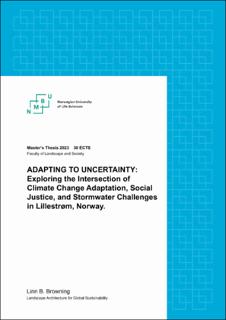| dc.description.abstract | As climate change presents escalating challenges in urban environments, the criticality of effective stormwater management intensifies. This study investigates the potential role of landscape architecture in amalgamating principles of social justice, sustainability, and adaptive capacity, aiming to ensure an equitable distribution of adaptation benefits and burdens.
Adopting an interdisciplinary methodology and utilizing systems thinking, this research assesses current climate-related strategies, identifies potential areas for improvement, and explores the complexities of implementing nature-based solutions in urban areas at risk. The study integrates methodologies from multiple disciplines, including a comprehensive literature review, detailed document analysis of prevailing laws and local guidelines, and advanced spatial analysis employing Geographic Information Systems (GIS) and landscape architecture spatial analysis methods, such as the SCALGO Live tool for analyzing hydrological risk. Through these methods, it seeks to highlight physical vulnerabilities in the landscape that significantly impact homeowners and residents under the existing stormwater management legislation.
The case study of Lillestrøm, Norway—a city grappling with high homeownership rates, rapid urban densification, and vulnerable topography—provides the context for examining how socioeconomics, urbanization trends, and legal definitions intersect with climate change adaptation strategies. The research elucidates the implications of the emerging privatization trend in stormwater management, emphasizing its potential to increase hazard exposure and vulnerability among a significant portion of the population to cloudbursts and extreme rainfall events.
Results suggest that although nature-based solutions contribute to sustainable urban development, their effectiveness is impeded by the lack of a shared understanding and clarity in management frameworks. Therefore, this study advocates for a common language and consensus on the principles of climate change adaptation, social justice, and sustainability within the field of landscape architecture.
While the insights gleaned from this research are rooted in the specific context of Lillestrøm, they offer broader relevance, contributing to a nuanced understanding of urban climate change adaptation challenges on a global scale, and providing valuable insights for future climate justice and adaptation strategies. | |
